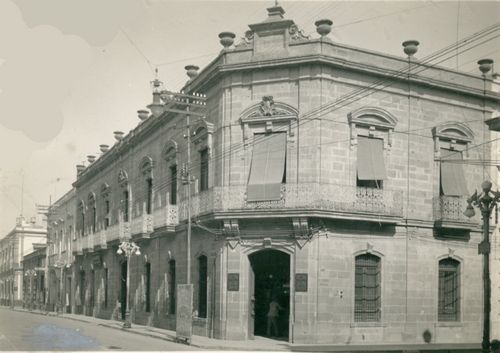El Banco de Jalisco
On 26 July 1898 Ramón Alcázar, representing himself and a group of leading businessmen (Manuel, Justo and Francisco de Paula Fernández del Valle, Antonio Gas, José S. García, Manuel L. Corcuera, Fortoul Chapuy y Compañía, Francisco Martínez Negrete é hijos and Moreno Hermanos), signed an agreement with the Secretaría de Hacienda to establish a bank of issue in Guadalajara.
The first board consisted of Justo Fernández del Valle as Presidente, Francisco Martínez NegreteFrancisco Martínez Negrete Alba was the son of Francisco Martínez Negrete Ortiz de Rosas, who had built up his business, developing relationships with the other businessmen in Jalisco, including through marriage. The younger Francisco’s sisters María Dolores and María Ignacia Martínez Negrete, married José María and Pío Bermejillo. María Josefa and Rosalía married Justo and Manuel Fernández del Valle, while the last of his sisters, Francisca, married Agapito Fernández Somellera, after the death of his first wife, Lorenza Martínez-Negrete. Little by little these sons-in-law of the elder Francisco joined the family business. as Vicepresidente, José Lauro García as primer vocal, Manuel L. Corcuera as segundo vocal and Antonio Gas as tercero vocalEl Popular, Año II, Núm. 531, 26 June 1898. A more substantive board had been formed by November, with Justo Fernández del Valle also acting as manager until a definite appointment was madeEl Popular, Año II, Núm. 634, 8 October 1898. The full line-up was Vocales propietarios: Diego Moreno, Justo Fernández del Valle, Antonio Gas, José L. García and Manuel Corcuera; Vocales Suplentes: Manuel Fernández del Valle, Francisco Martínez Negrete and D. Luis Fortoúl; Comisarios: Francisco de P. Fernández del Valle and. Ramón Alcazar (El Correo Epañol, Año II, Núm. 634, 3 October 1898) .

The bank opened for business on 28 November 1898La Voz de México, Tomo XXIX, Núm. 24, 29 November 1898: Semana Mercantil, 2a Epoca, Año XV, Núm. 1, 2 January 1899 in a building on the calle López CotillaLa Patria, Año XXII, Núm. 6,621, 1 December 1898. At first the bank’s notes had difficulty circulating because the already-established branches of the Banco Nacional de México and Banco de Londres y México refused to accept themLa Patria, Año XXII, Núm. 6,642, 28 December 1898.
On 15 November 1899 the board approved the establishment of a branch in TepicEl Contemporaneo, Tomo IV, Núm. 987, San Luis Potosí, 25 November 1899, the Secretaría de Hacienda gave its approval on 28 December and the branch opened at calle de México 32 in July 1900Diego Moreno and Salvador Velasco, prominent merchants and landowners in the area, had represented the bank in negotiations (La Libertad, Morelia, tomo 10, núm. 11, 14 March 1902). The first manager was Carlos Llaguno y del Hoyo, the cajero-contador Juan Camargo and the board composed of José María Menchaca, Germán Helmrich, Andrés Chaurand and José Vargas (La Democracia, Tepic, 22 July 1900). Camargo replaced Llaguno as manager in September 1900 (La Democracia, Tepic, 2 September 1900).
On 2 June 1900 the Secretaría de Hacienda authorised the bank to open a branch in Colima but because of staffing difficulties the bank had to ask for two separate extensions and the branch was never opened. On 24 August 1901 the Secretaría de Hacienda authorised the bank to open a branch in Zamora, Michoacán, and this opened in March 1902The first manager was Carlos Llaguno y del Hoyo, the cajero-contador Joaquín Varela and the board composed of José María Dávales, Francisco A. Madrigal, José Méndez and Manuel García Vallejo Ruiz (La Voz de México, Año XXXII, Núm. 64, 19 March 1902). Finally, a branch was established in Ciudad Guzmán (Zapotlán) on 31 March 1903letter of interventor Gómez y Velasco, 31 March 1903, in Memorias de las Instituciones de Crédito correspondiente al año 1903.
The Banco de Jalisco suspended its operations in Guadalajara at the begining of June 1914. According to a newspaper report it was at first believed that this was due to financial difficulties, but the manager explained that the bank had been closed by order of the government because it had failed to deliver $600,000 in connection with the internal loan that Huerta floated several months beforeEl Paso Herald, 7 July 1914. Another version was that the Huertista commander, General Mier, asked the Secretaría de Guerra y Marina for money to pay his troops, and the department told him to request the money from the Banco de Jalisco, which refused. Then the Secretaría authorized, or rather ordered, General Mier to force a loan. Mier refused several times but eventually his soldiers forced the directors to open their strongroom and extracted around $300,000, of which $15,000 were in gold, $60,000 and the rest in banknotesEl Imparcial, Tomo XXXVI, Núm. 1920, 27 July 1914.
On 13 July 1915 Obregón reported that the bank had reopened after he threatened that if it did not do so within five days to honour the notes it had in circulation he would confiscate its propertiesABarragán, caja II, exp. 23, telegram Obregón, Guadalajara to Carranza, Monterrey, 13 July 1915.
Because of the sums that the bank eventually had to subscribe for Huerta’s loan on 15 December 1915 the Comisión Reguladora e Inspectora de Instituciones de Crédito found that it did not have enough in assets to underwrite its notes in issue and so cancelled its concession. However, under Obregón's decree of 31 January 1921 the bank was placed into Class A (for banks whose assets were greater than their liabilities) and allowed to resume all customary operations except the issue of bank notes.
